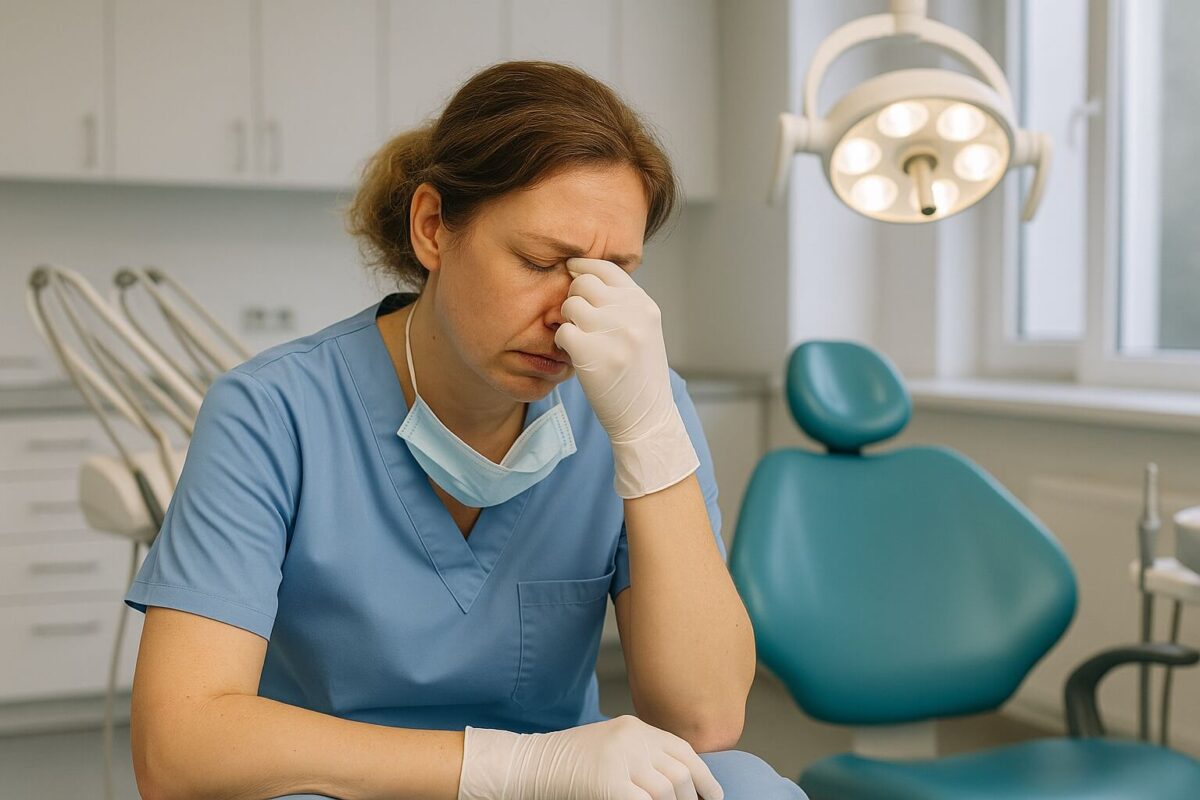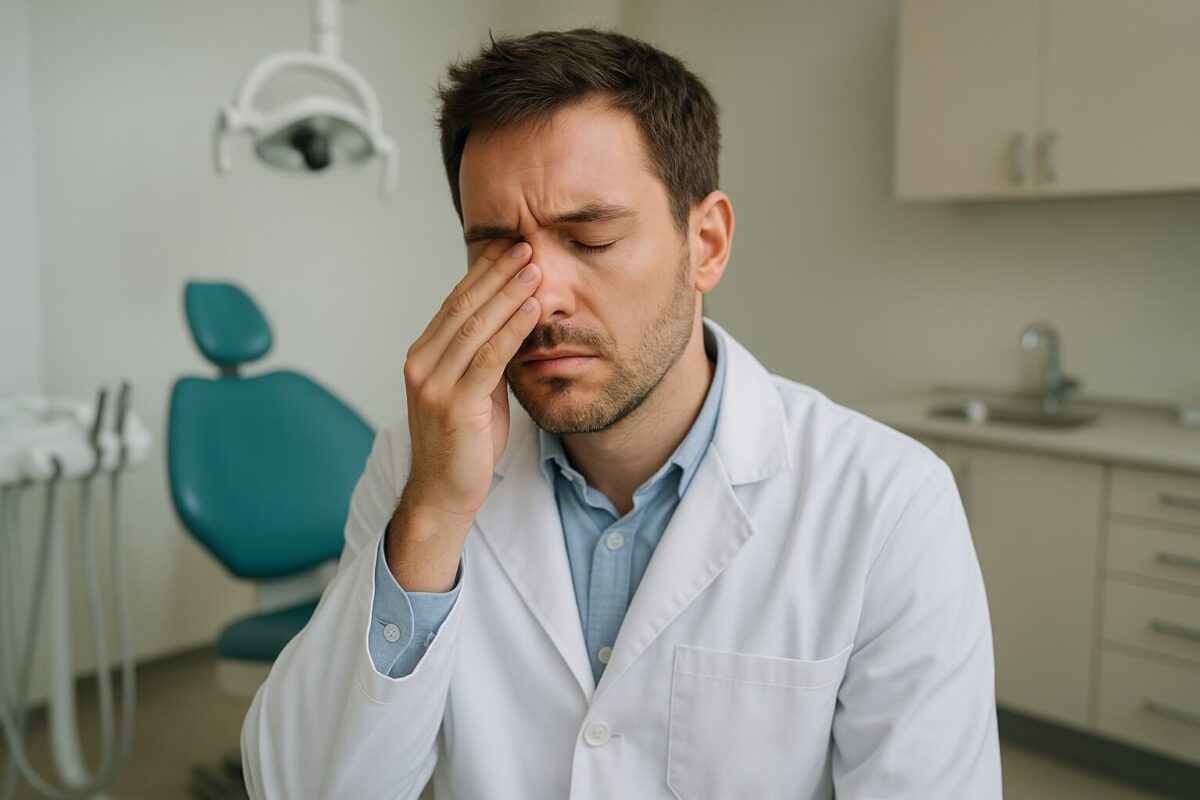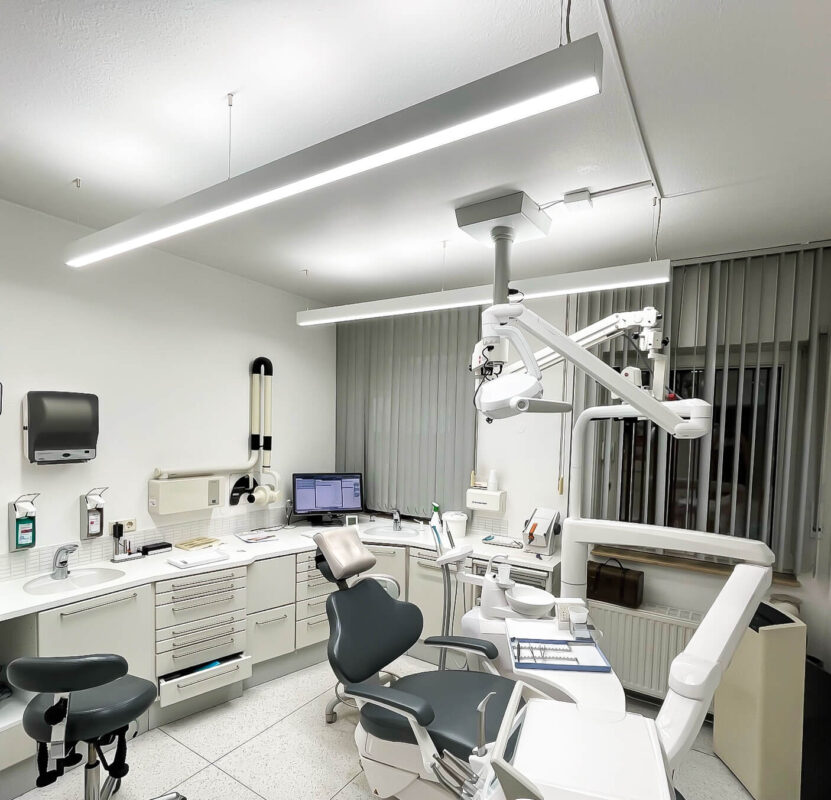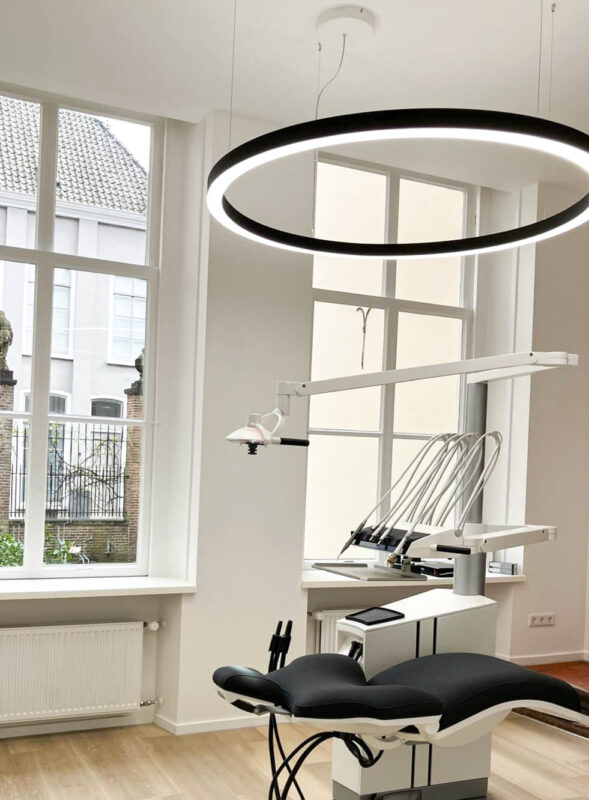Adaption and Accommodation in the Eyes — Why Correct Lighting in the Dental Treatment Room Is Essential for Ergonomics and Visual Comfort
Introduzione
Questo articolo fa parte della nostra serie sui fattori che causano l’affaticamento dei professionisti del settore dentale e su come una progettazione ergonomica dell’illuminazione può aiutare a prevenirlo.

Per i dentisti e gli igienisti dentali, gli occhi stanchi sono tra le fonti più comuni di stanchezza a fine giornata. La costante alternanza tra lampade operative luminose e ambienti più scuri costringe gli occhi ad adattarsi ripetutamente, creando un affaticamento visivo che influisce sulla concentrazione, sul comfort e sulla postura.
L’odontoiatria dipende dalla precisione visiva: individuare le sfumature di colore, lavorare in spazi ristretti e mantenere la concentrazione per ore. Questi compiti si basano su due meccanismi visivi: l’
La comprensione di questi processi spiega perché un ‘illuminazione corretta e uniforme nelle sale di trattamento odontoiatrico non è un lusso ma una necessità ergonomica.
Two fundamental visual processes — accommodation (focusing between near and far) and adaption (adjusting to different light levels) — are constantly at work in every dental procedure. When the lighting in the dental treatment room is unbalanced or poorly distributed, these mechanisms are overstrained, leading to eye fatigue, loss of concentration, headaches, and eventually musculoskeletal tension.
Understanding how accommodation and adaption function — and designing lighting that supports them — is at the heart of ergonomic lighting for dentistry. This is why correct lighting for dental treatment rooms, with balanced full daylight spectrum LED illumination, is essential to safeguard both visual health and clinical precision.
Key Takeaways
- Accommodation allows the eyes to shift focus between near and far distances (e.g., between patient’s mouth, instruments, and monitor).
- Adaption (adaptation) enables the eyes to adjust to changes in brightness (e.g., bright operating lamp vs dim ambient light).
- Poor lighting contrast, low CRI LEDs, and insufficient ambient illumination increase visual workload and fatigue.
- Optimal lighting for dental treatment rooms should provide:
- 1,500–2,000 lux around the patient’s mouth (working field)
- ≥700 lux in the surrounding room
- Light contrast ratio ≤10:1 between operating light and ambient light
- Uniform, shadow-free, flicker-free illumination
- Full-spectrum, high-CRI LED lighting that mimics natural daylight
- Balanced lighting improves ergonomics for dentists, visual comfort, and overall performance during dental procedures.
- 1,500–2,000 lux around the patient’s mouth (working field)
1. Visual Demands in the Dental Treatment Room
Dentistry requires continuous visual precision — detecting microfractures, assessing shade differences, and maintaining focus at short working distances for hours. These visual tasks depend on:
- High illuminance levels for clarity
- Accurate color rendering to distinguish tissues and materials
- Evenly distributed light to prevent sharp shadows or glare
Studies have shown that uneven lighting and excessive contrast between the working field and the surrounding room trigger repetitive accommodation and adaptation cycles, leading to visual strain and fatigue (MedCrave Journal of Dentistry, 2020; Dimensions of Dental Hygiene, 2018).
2. What Is Visual Accommodation?
Accommodation is the process by which the eye’s ciliary muscles adjust the curvature of the crystalline lens, allowing the eye to focus on near or distant objects.
- In dentistry, this means rapidly shifting focus between:
- The patient’s mouth (≈ 30–40 cm distance)
- Dental instruments or mirror reflections
- Monitor screens or assistants
- The patient’s mouth (≈ 30–40 cm distance)
- Constant refocusing places a muscular load on the eyes, especially when lighting contrast is high or edges are poorly defined.
- Low-contrast lighting or shadows increase this effort, accelerating eye fatigue and reducing visual accuracy.
Scientific reference:
Accommodation mechanisms are well described by Ciuffreda & Rosenfield (Annual Review of Vision Science, 2020), who note that near-work environments with poor lighting dramatically increase accommodative stress.
4. How Lighting Design Impacts Dental Ergonomics
Correct lighting design for dental treatment rooms minimizes the strain from adaptation and accommodation. Ergonomic lighting supports visual stability, color accuracy, and comfort, allowing dentists to focus on procedures rather than their eyes adjusting.
Recommended Lighting Parameters
Lighting Zone | Recommended Illuminance | Purpose |
Working field (patient’s mouth) | 1,500–2,000 lux | Optimal precision and shade matching |
Ambient/room lighting | ≥ 700 lux | Prevents visual adaptation stress |
Light ratio (max/min) | ≤ 10:1 | Reduces adaptation load |
Color Rendering Index (CRI) | ≥ 97 (full daylight spectrum) | Natural color perception |
UGR (Unified Glare Rating) | < 19 | Reduces glare and discomfort |
Flicker | < 1% modulation | Prevents neurological and visual strain |
Design Strategies
- Use bi-directional lighting (direct + indirect) for uniform brightness.
- Evita gli angoli bui o le transizioni ad alto contrasto tra soffitto e pareti.
- Integrare illuminazione a LED a spettro completo e senza sfarfallio che riproduce la luce del giorno (5.500-6.000 K).
Scegli layout di illuminazione che distribuiscano la luminosità in modo uniforme, come i modelli DentLED PHL e PVR che combinano illuminazione verticale e orizzontale.

5. Ergonomia per dentisti: Oltre la postura
Mentre l’ergonomia dentale si concentra spesso sulla postura e sulle sollecitazioni muscolo-scheletriche, l’ergonomia visiva è altrettanto importante.
- L’affaticamento degli occhi influisce sulla concentrazione, sulla precisione e persino sulla postura del corpo.
- I dentisti che soffrono di affaticamento visivo tendono a piegarsi in avanti o a riposizionarsi per migliorare la visibilità, aumentando così l’affaticamento del collo e della schiena.
- Un’illuminazione corretta e distribuita in modo uniforme permette una visione rilassata e favorisce una una postura neutra per tutta la durata delle procedure.
Riferimento:
Una revisione del 2022 nella rivista International Journal of Environmental Research and Public Health conferma che l’ergonomia visiva e l’illuminazione adeguata influenzano direttamente la postura fisica e la salute muscolo-scheletrica dei professionisti del settore dentale.
6. Benefits of Full Daylight Spectrum Lighting
Modern full-spectrum LED lighting (CRI ≥ 97) closely replicates natural daylight, improving color discrimination, contrast sensitivity, and visual comfort.
- Enhances accuracy during dental procedures such as shade matching, endodontics, and cosmetic restorations.
- Reduces adaptation strain by providing a balanced spectral distribution across the entire workspace.
- Promotes overall well-being and circadian balance, which are increasingly recognized components of healthy lighting for healthcare environments.
7. Conclusion
Il comfort visivo in odontoiatria non è un lusso, ma una necessità ergonomica. necessità ergonomica.
Comprendendo l’accomodamento e adattamentoe applicando principi di progettazione illuminotecnica scientificamente fondati principi di progettazione illuminotecnicai professionisti del settore dentale possono proteggere gli occhi, migliorare le prestazioni e mantenere la concentrazione per tutto il giorno.
A well-illuminated dental treatment room — using DentLED full daylight spectrum lighting — ensures that the light level difference between operating and ambient zones is balanced, shadows are eliminated, and every detail remains clear and natural.
Healthy eyes work better — and for longer — under healthy light.

